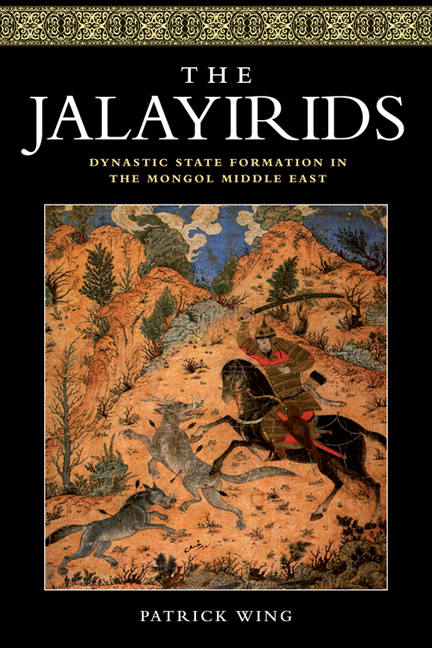Book contents
- Frontmatter
- Contents
- List of Illustrations
- Acknowledgements
- Abbreviations for Primary and Secondary Source Texts
- 1 Introduction and Sources for the History of the Jalayirids
- 2 Tribes and the Chinggisid Empire
- 3 The Jalayirs and the Early Ilkhanate
- 4 From Tribal Amirs to Royal In-laws
- 5 Crisis and Transition (1335–56)
- 6 Shaykh Uvays and the Jalayirid Dynasty
- 7 Dynastic Ideology during the Reign of Shaykh Uvays
- 8 Challenges to the Jalayirid Order
- 9 Conclusions and the Legacy of the Jalayirids
- Maps and Genealogical Chart
- Bibliography
- Index
2 - Tribes and the Chinggisid Empire
- Frontmatter
- Contents
- List of Illustrations
- Acknowledgements
- Abbreviations for Primary and Secondary Source Texts
- 1 Introduction and Sources for the History of the Jalayirids
- 2 Tribes and the Chinggisid Empire
- 3 The Jalayirs and the Early Ilkhanate
- 4 From Tribal Amirs to Royal In-laws
- 5 Crisis and Transition (1335–56)
- 6 Shaykh Uvays and the Jalayirid Dynasty
- 7 Dynastic Ideology during the Reign of Shaykh Uvays
- 8 Challenges to the Jalayirid Order
- 9 Conclusions and the Legacy of the Jalayirids
- Maps and Genealogical Chart
- Bibliography
- Index
Summary
The Jalayirid dynasty takes its name from Jalayir, the name of a Mongolian tribe from which it was descended. In order to understand the historical factors that led to members of the Jalayir establishing an Islamic sultanate in Iran and Iraq in the fourteenth century, we need first to examine some aspects of tribal society in inner Asia. Foremost, we need to address the question, what do we mean when we talk about ‘tribes’? This chapter provides an overview of scholarship on inner Asian tribes, particularly those in Mongolia on the eve of the empire of Chinggis Qan. In addition, the impact of the Chinggisid empire on the tribes, and particularly on the Jalayir, is explored. The foundation of the empire resulted in a Jalayir diaspora, as members of this group were redistributed across Eurasia in accordance with new imperial political and social institutions.
Tribe and State Formation under the Mongols
Mongol society was tribally organised. That is, society was divided among several identity groups that are mentioned in sources like the SecretHistory of the Mongols and that have been characterised as tribes or clans by modern scholars. The literature on tribes in the fields of anthropology and history is vast, and the precise definition of ‘tribe’ is the subject of an ongoing scholarly debate. While it is impractical to try to sort out all of the various arguments of the literature about tribes since the nineteenth century, we need to address some key issues in order to deal with the specific case of the Jalayir tribe and the history of this group from the thirteenth to the fifteenth century. These issues include clarifying some of the major interpretations of the characteristics, functions and ideology of inner Asian tribes.
One of the most salient characteristics of tribes in inner Asia and elsewhere is that they are conceived of by their members as describing kinship relations. That is, tribes are groups defined by real or imagined blood relationships, in the same way that craft guilds are defined by one's profession, or citizenship is defined by one's national homeland.
- Type
- Chapter
- Information
- The JalayiridsDynastic State Formation in the Mongol Middle East, pp. 29 - 47Publisher: Edinburgh University PressPrint publication year: 2016



